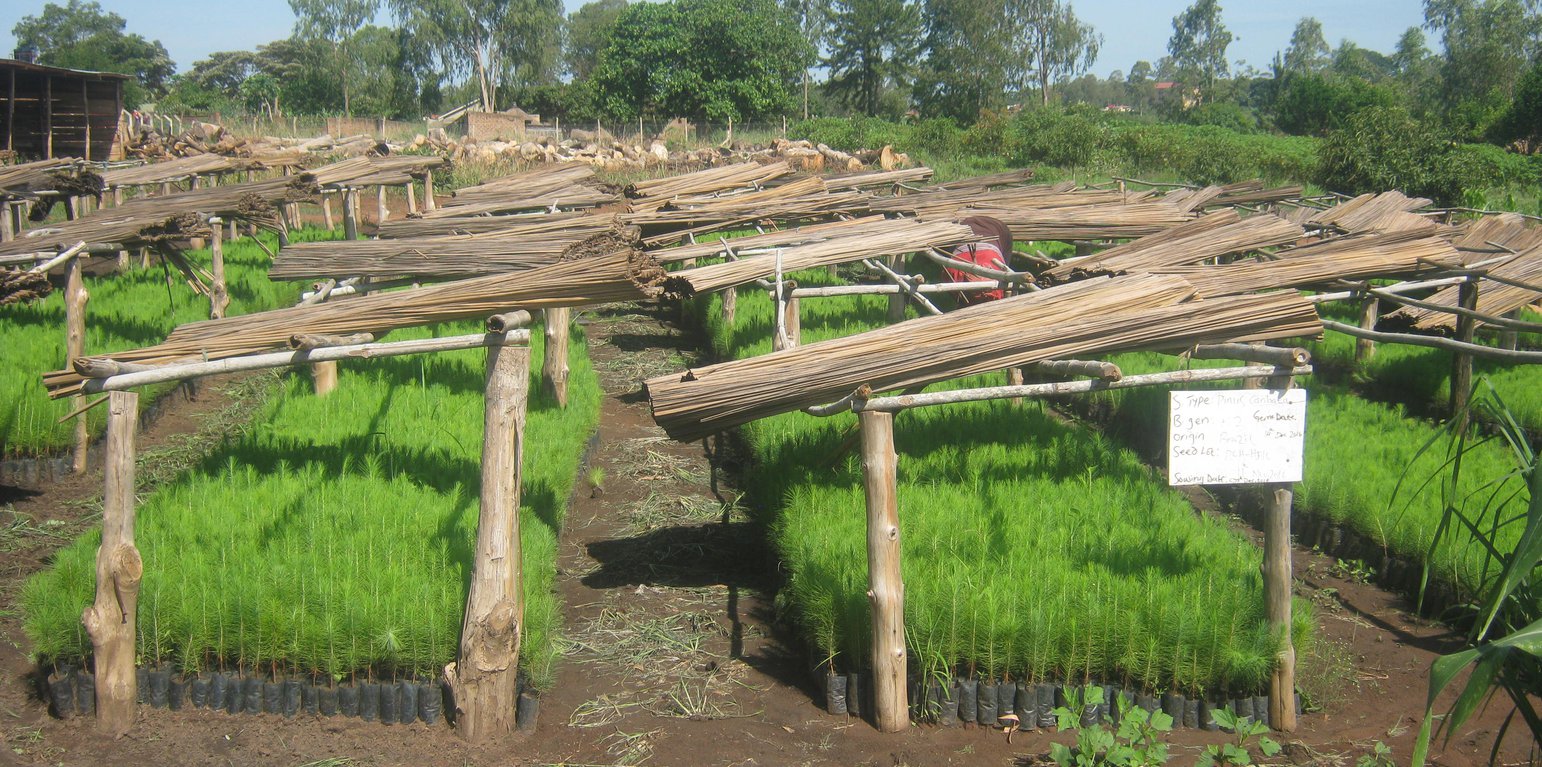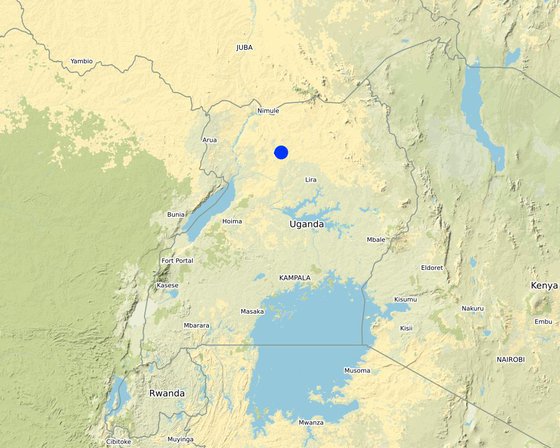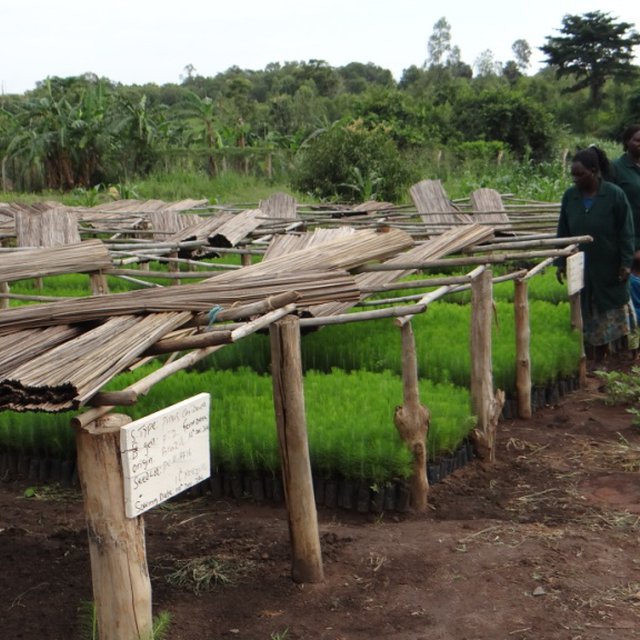



A farmer started the approach locally and later obtained training and approval to operate as certified tree nursery bed operator by the national forestry authority (NFA) to promote quality tree seedlings promotion. Northern Uganda normally experiences devastating fire outbreaks during dry seasons (November-March) which usually destroy vegetation covers. This leaves the land bare resulting in persistent soil erosion, low soil fertility, low production and low incomes. This is the reason to promote tree nurseries as an alternative source of income. The approach promotes environmental conservation through tree planting, triggers saw-log production, sustainable land utilization and increases household income from the sale of tree seedlings.
The nursery bed project was linked to a saw log production scheme Grant (SPGS) by the National Forestry Authority (NFA) who have supported and trained the farmer with grants/money for procuring the tree seeds from countries like Australia, Brazil and South Africa. This individual farmer together with SPGS and partners first developed guidelines (similar to a community’s constitution) informing on how to establish and manage tree nurseries plantations including marketing products for value addition. The guidelines highlight that:
(1) Prospective beneficiaries must be organized individuals operating a tree nursery bed
(2) The nursery bed should be certified resp. approved by the forestry authority (NFA)
(3) Nursery owners must train other community members on tree nursery bed establishment and tree planting
(4) Nursery owners must provide tree seedlings to other community members for purchase
(5) Beneficiaries must be in position to plant tree seedling in own fields which would, in turn, act as a demonstration site
(6) Beneficiaries should have willingness and ability to perform according to the guidelines (https://www.yumpu.com/en/document/view/37755510/spgs-tree-planting-guidelines for-Uganda-all-chapters-low).
Trees seedling procured by interested farmers are planted into the established seedbed at the onset of the rains under the supervision of the nursery bed owner. The community performs plantation planning meetings and training / exchange visits to empower other farmers to mobilize resources for environmental conservation. Up to now, participating farmers have been involved in raising over 350000 tree seedlings for timber and other tree species per year from 2007.
Benefits linked to this approach include the presence of the leadership committee supported by the guidelines/constitution to guide the farmers' activities, farmer-to-farmer learning, demonstration plots, and access to information and decision support on commercial forest plantation establishment.
The sale of products as well as environmental services has enabled the farmers’ community to extend its networks and partnerships beyond SPGS. Farmer communities also supply tree seedlings to churches, schools and other private clients. They do demonstrations and give advice to farmers so that their seedlings survive.

地点: Gulu Municipality, Northern Uganda., 乌干达
启动日期: 2007
终止年份: 不适用
方法的类型
| 该方法涉及哪些利益相关者/执行机构? | 指定利益相关者 | 说明利益相关者的角色 |
| 当地土地使用者/当地社区 | Local communities | Implementation and use of approach |
| SLM专家/农业顾问 | Small Production Grants Scheme (SPGS),National Forestry Authority (NFA),Uganda Tree Grower Association | Research |
| 研究人员 | National Forestry Authority students | Field work and data collection for publication |
| 教师/学龄儿童/学生 | University students, primary and secondary teachers. | Field work and support trainings |
| NGO | Food and Agriculture Organisation (FAO), Uganda Timber Growers Association (UTGA) | Support trainings |
| 地方政府 | Councillors and Forestry officers | Linkage to NGO's, training's and administrative guidance as well as security |
| 国家政府(规划者、决策者) | National Forestry Authority (NFA) | Planning and Commissioning |
| 国际组织 | Food Agriculture Organisation (FAO) | Funding |
决策是由......做出的
决策是基于
SPGS and university students
Formulation and implementation of bylaws, Trainings, Exchange visits.
Farmers are able to utilise their land through tree planting
Decision on when to plant the tree nurseries
Incentives based (in form of trainings and seedlings)
Coordinated by the land user. Strengthened working as a group (hired labour).
Land user can easily borrow interest free loan from the bank
Access to technologies (seedlings), knowledge on planting, spacing and pruning and thinning
Especially farmers involved and partners
Different partners participated and contributed to implementing the approach. Community bylaws and functioning committee.
Conflicts between the land user and livestock owners (Free grazing on trees). Conflicts resolved using bylaws.
Focus was not on well off women farmers but those who had interest in tree planting as an individual or group
Women are the majority who buy seedlings, eldery and youths
Those who belong to the households from which members came from to buy tree seedlings
Focused more on training and production
Income from the sale of tree products was used for buying food
Good quality tree products. Linkage done by SPGS.
Nursery bed based near the a stream for easy watering
Source of fuel wood
Carbon sequestration
Farm workers in the tree nursery bed and plantations
The land user is involved in selling tree seedlings, trees and the income obtained is used to manage the nursery bed and forest activities like fireline, weeding etc. The presence of an organised leadership. With better management skills to manage, the land user will keep working very closely with other groups .